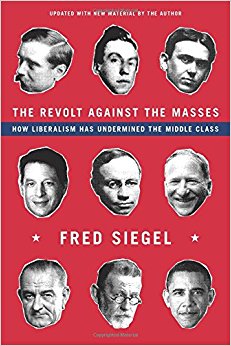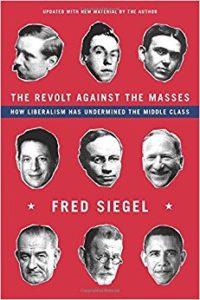As I was reading Fred Siegel’s book I kept thinking how hopeless I felt (politically and culturally speaking), like most conservatives, during Obama’s reign. Not only did cultural elites hate our Judeo-Christian values, now the power of the federal government was being used to try to shut us up. The cultural elites haven’t changed (only gotten more hysterical), but boy is there a new Sherriff in town!
The book is a history of modern liberalism from its progressive roots in the early 20th Century to Obama, a history every conservative should know. Most Americans, if they knew the actual, objective historical facts about the founding of modern liberalism, would be appalled. And it isn’t just the founding. The attitudes and beliefs of early liberals are effectively the same as liberals today. The latter just got better at hiding them as time went on. The Trump era changed all this; the left isn’t hiding its true stripes anymore.
The late 19th and early 20th centuries was a period of immense change and social upheaval. The rise of modern science and advances in technology caused a largely agrarian and rural society to transform into an industrial and urban one in a relatively short period of time. Cultural elites, especially intellectuals, were convinced the answer to such social disruption certainly didn’t lie in a 100 plus year-old constitution. What was needed was new thinking for a new age, and out of this grew progressivism. You might detect a bit of hubris in such a moniker, and you would be right. Progress as elites understood it included rejecting the past; any knowledge or insights gained in ancient times, be that of ancient Hebrews, Greeks, or Christians couldn’t have any relevance to an advanced, modern society.
In addition to an indifference for the past, all progressives loathed capitalism and disdained the masses of the uneducated hoi polloi. The great unwashed needed their educated betters to provide a life they were unable to provide for themselves, and unenlightened enough to attain. This eventually led to the conviction that the people must be ruled by an educated elite of technocrats.
But before liberalism took over American government and politics, they infiltrated culture first. As Andrew Breitbart used to say, politics is downstream from culture, and starting in the 1920s liberalism began to take over the culture, specifically in the arts and entertainment, education, and media. The book is full of examples, but the writer Sinclair Lewis stands out. Here’s how Siegel describes Lewis’ 1920 book, Main Street:
Main Street caught the post-war literary mood of disillusion perfectly. It distilled and amplified the sentiments of Americans who thought of themselves as members of a creative class stifled by the conventions of provincial life. It’s the story of Carol Kennicott, a sensitive young woman from the big city who is trapped by a nearly loveless marriage with a stodgy middle-class husband. She’s also imprisoned by a small-town life in Gopher Prairie, a dreary Midwestern settlement dominated by Rotarians. Carol, like Randolph Bourne, was repelled by the “grayness” and “dullness” of “Shabby” town life in America. Unlike the towns of an idealized Europe, characterized by “noble aspiration” and a “fine aristocratic pride,” Gopher Prairie . . . was defined by the “men of the cash-register . . . who make the town a sterile oligarchy.”
Carol is tormented by the self-satisfied mediocrity that surrounds her. She dreams of a “better life,” of “a more conscious life,” though the is never able to define it.
Siegel’s description reminds me of the 2008 movie Revolutionary Road with Kate Winslet and Leonardo DiCaprio. Read the description of the movie; it’s Lewis set in the ostensibly stultifying suburbia of the 1950s. It should not surprise us that the presidential election of 2016 was defined by rural and suburban red, and urban blue. From the 1920s on, liberals have expressed contempt for those who live outside their urban bubble.
This contempt is also reflected in the liberal conviction that the economy and our lives must be managed by a coterie of experts. Only government could make America great, not its people. This idea burrowed its way deep into the liberal psyche with the Great Depression and the apparent failure of capitalism. Journalist Lincoln Steffens expressed admiration for the Soviet Union in the early 1930s that was, he believed, setting up a “dictatorship supported by a small trained minority, to make and maintain for generations a scientific arrangement of economic forces.” This same spirit animated the architects of Obamacare, and that is soon to be joined in the dustbin of history with the USSR.
I could make this a very long post, but I will comment on one more thing. Modern liberals often refer to themselves as progressives, but Siegel insists modern liberalism is not progressive at all. Starting in the 1960s liberalism gave up on the idea of progress and embraced a dystopian vision of the future. He targets the publication of the 1962 book Silent Spring as when progressives gave up on progress and became liberals. As the cover says, “The classic that launched the environmental movement.” Liberals have predicted one disaster after another ever since. And of course the answer is always ever expanding government, higher taxes, and the curtailing of individual liberty. Early progressives would think they have nothing in common with modern liberals.
When Siegel published the book in 2013 nobody could have imagined that it would be one Donald J. Trump who would slay the great liberal dragon, but slay he did. We’ll see how successfully he does it as President.


